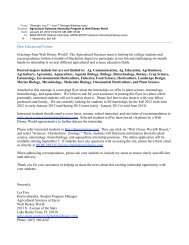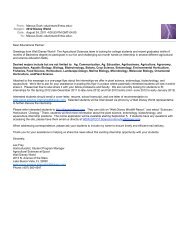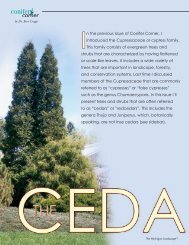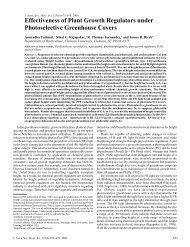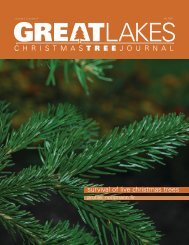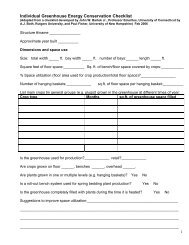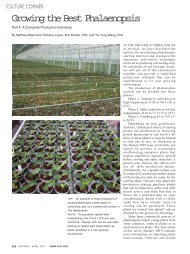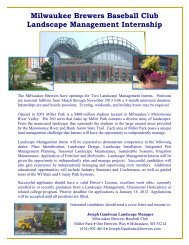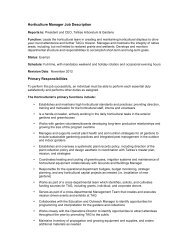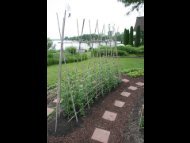concolor fir - Michigan State University
concolor fir - Michigan State University
concolor fir - Michigan State University
Create successful ePaper yourself
Turn your PDF publications into a flip-book with our unique Google optimized e-Paper software.
volume 4 | number 2 spring 2009<br />
<strong>concolor</strong> <strong>fir</strong><br />
& christmas tree check off
conifer species profile<br />
spring 2009<br />
great lakes christmas tree journal<br />
Conifer Species Profile:<br />
Abies <strong>concolor</strong> Concolor <strong>fir</strong>, white <strong>fir</strong><br />
By: Bert Cregg, <strong>Michigan</strong> <strong>State</strong> <strong>University</strong><br />
This edition of our Conifer Species Profiles features one of the most interesting and versatile conifers<br />
grown for Christmas trees in the Great Lakes region, Abies <strong>concolor</strong>.<br />
Abies <strong>concolor</strong> ‘Select’ features<br />
upright, blue needles.<br />
4
Needle color and needle retention vary with seed source of <strong>concolor</strong> <strong>fir</strong>. Left to right:<br />
San Juan, Rio Grande, Lincoln, Apache. Photo courtesy Dr. Rick Bates, PSU.<br />
Form, color, scent, needle retention.<br />
Concolor <strong>fir</strong> has all the traits of a great<br />
Christmas tree. Photo courtesy Dr. Rick<br />
Bates, PSU.<br />
In the eastern U.S. Abies <strong>concolor</strong> is<br />
commonly referred to as <strong>concolor</strong> <strong>fir</strong>,<br />
while in the West it is usually called white<br />
<strong>fir</strong>. Regardless of what you call it, Abies<br />
<strong>concolor</strong> is an outstanding tree that offers<br />
a change of pace as a Christmas tree and<br />
makes a great landscape specimen as well.<br />
Native range and environment<br />
Abies <strong>concolor</strong> is native to the Sierra<br />
Nevada Mountains of southern Oregon<br />
and California and is widely distributed<br />
in the southern Rocky Mountains.<br />
Variation between the two regions of<br />
Abies <strong>concolor</strong> is sufficient that two varieties<br />
are commonly recognized; var. <strong>concolor</strong>,<br />
Rocky Mountain white <strong>fir</strong>, and var. lowiana,<br />
California white <strong>fir</strong>. The Rocky<br />
Mountain form is adapted to high elevations<br />
(7,000-9,000 feet), short growing seasons<br />
and low rainfall. California white <strong>fir</strong>,<br />
in contrast, is adapted to relatively warmer<br />
conditions and higher rainfall.<br />
Because of this, var. lowiana is not suited<br />
for the Lake <strong>State</strong>s. <strong>Michigan</strong> <strong>State</strong><br />
<strong>University</strong> Forest Geneticist Dr. Jonathan<br />
Wright attempted to grow seedlings of<br />
California white <strong>fir</strong> in early genetics trials<br />
and found that all were killed back to<br />
snow level in <strong>Michigan</strong> winters. Rocky<br />
Mountain white <strong>fir</strong> occurs in widely scattered<br />
populations throughout the southern<br />
Rockies. Because of geographic isolation<br />
among populations and diverse soils<br />
and climate, Abies <strong>concolor</strong> shows a high<br />
degree of genetic variation in growth rate<br />
and form (see discussion below). Within<br />
the genus Abies, <strong>concolor</strong> <strong>fir</strong> is classified<br />
in the section Grandis and grand <strong>fir</strong> (A.<br />
grandis) is the very closely related. Abies<br />
<strong>concolor</strong> and A. grandis naturally hybridize<br />
forming an introgression zone where<br />
the range of the two species overlap.<br />
Use as a Christmas tree<br />
Concolor <strong>fir</strong> represents a small but<br />
increasing segment of the Christmas tree<br />
market. Among true <strong>fir</strong>s (Abies spp.) in<br />
<strong>Michigan</strong>, <strong>concolor</strong> <strong>fir</strong> ranks a distant second<br />
to Fraser <strong>fir</strong> (Abies fraseri) but the<br />
total acreage in <strong>concolor</strong> production<br />
nearly doubled from 1994 to 2005 to<br />
1,100 acres. The appeal of <strong>concolor</strong> <strong>fir</strong> as<br />
a Christmas tree is unmistakable.<br />
Concolor <strong>fir</strong> has a stately symmetrical<br />
growth habit when young. Needles are<br />
typically blue-green and, in some cases,<br />
can be a dramatic powder blue. Needles<br />
of <strong>concolor</strong> <strong>fir</strong> are longer than most other<br />
<strong>fir</strong>s commonly grown for Christmas trees,<br />
giving trees a coarser texture than most<br />
other <strong>fir</strong>s. Branches are still and hold<br />
Needles of <strong>concolor</strong> <strong>fir</strong> are<br />
longer than most other <strong>fir</strong>s<br />
commonly grown for<br />
Christmas trees, giving<br />
trees a coarser texture<br />
than most other <strong>fir</strong>s.<br />
ornaments well. Concolor needles have a<br />
pleasant scent that is usually described as<br />
citrus- or orange-like. Needle retention is<br />
excellent, though it varies by seed source<br />
(see discussion below). Because of its<br />
unique appearance, consumer attitudes<br />
toward <strong>concolor</strong> <strong>fir</strong> may be best<br />
described as ‘love it or leave it’. Christmas<br />
tree grower and nurseryman Jerry<br />
Peterson notes, “Some chose-and-cut customers<br />
go straight for the <strong>concolor</strong>s and<br />
others wouldn’t take one if you gave it to<br />
them.” Once consumers choose <strong>concolor</strong><br />
it often becomes a favorite and the average<br />
wholesale price of <strong>concolor</strong> <strong>fir</strong> ($19/<br />
tree in 2005) is second only to Fraser <strong>fir</strong>.<br />
For growers, one of the principle liabilities<br />
of <strong>concolor</strong> is early budbreak resulting in<br />
5
conifer species profile<br />
spring 2009<br />
great lakes christmas tree journal<br />
Range map of<br />
Abies <strong>concolor</strong>.<br />
Concolor <strong>fir</strong> has a<br />
wide but disjunct<br />
distribution in<br />
the Southwest,<br />
resulting in a<br />
high level of population<br />
variation.<br />
Concolor <strong>fir</strong> is among the <strong>fir</strong>st species to<br />
break bud and therefore susceptible to<br />
late frosts.<br />
Concolor <strong>fir</strong>’s combination of adaptability and aesthetic<br />
appeal make it the most widely used true <strong>fir</strong> in the<br />
landscape trade in the eastern United <strong>State</strong>s. Concolor<br />
<strong>fir</strong> is rated as hardy to zone 3 or zone 4 so it can survive<br />
winter throughout the Great Lakes region.<br />
late frost injury. Concolor <strong>fir</strong> is a good<br />
grower and growth rates are comparable<br />
to Fraser <strong>fir</strong>. Culturing <strong>concolor</strong> can take<br />
a little extra effort compared to Fraser,<br />
however. According to grower Dan<br />
Wamhoff, “Concolor can produce a good<br />
Christmas tree in a reasonable time, but<br />
tops can have some erratic growth and<br />
require some top-work to maintain a<br />
good leader.” While <strong>concolor</strong> <strong>fir</strong> cannot<br />
be considered ‘pest-free’ it generally has<br />
fewer pest problems than many other<br />
Christmas tree species. Like most <strong>fir</strong>s,<br />
Concolor is susceptible to balsam twig<br />
aphid and spider mites.<br />
Genetics<br />
As noted earlier, only the Rocky<br />
Mountain form of Concolor <strong>fir</strong>, var. <strong>concolor</strong>,<br />
is suited for planting in the Great<br />
Lakes region. Seed sources within the<br />
Rocky Mountains also show considerable<br />
variation. Provenance testing and grower<br />
experience indicate Santa Fe, Cibola, San<br />
Juan, and Rio Grande seed sources rate<br />
the highest in terms of overall growth,<br />
color and form. In a provenance test in<br />
Idaho the seed sources were ranked<br />
Rio Grande (NM)<br />
Santa Fe (NM)<br />
Cibola (NM)<br />
Kiabab (AZ)<br />
Lincoln (NM)<br />
Kaibab ranked below the <strong>fir</strong>st three<br />
due to slow growth rate. Lincoln was the<br />
fastest grower but experienced problems<br />
with twisted and/or multiple leaders.<br />
Needle retention also varies among seed<br />
sources. In a comparison of needle<br />
retention among <strong>concolor</strong> <strong>fir</strong> provenances<br />
at Penn <strong>State</strong>; Santa Fe and Rio Grande<br />
had the best needle retention, Apache<br />
had the poorest, and Lincoln was intermediate.<br />
Overall quality ratings of the<br />
seed sources during a 35-day display followed<br />
the same trend.<br />
Landscape use<br />
Concolor <strong>fir</strong>’s combination of adaptability<br />
and aesthetic appeal make it the<br />
most widely used true <strong>fir</strong> in the landscape<br />
trade in the eastern United <strong>State</strong>s.<br />
Concolor <strong>fir</strong> is rated as hardy to zone 3<br />
or zone 4 so it can survive winter<br />
throughout the Great Lakes region. As<br />
note earlier, <strong>concolor</strong> <strong>fir</strong> will tolerate<br />
poorer drainage and more alkaline soil<br />
pH conditions than most other <strong>fir</strong>s. It is<br />
important to keep in mind, however, that<br />
these tolerances are relative to other <strong>fir</strong>s;<br />
<strong>concolor</strong> will not do well in heavy clay<br />
or in standing water. Success of transplanting<br />
landscape-sized <strong>concolor</strong> <strong>fir</strong>s is<br />
usually high to good. Depending on the<br />
nursery site trees may sink some deep<br />
large roots, which makes lifting a challenge<br />
and increases loss of roots in transplanting.<br />
Standard techniques to<br />
6
Concolor <strong>fir</strong> makes a great landscape tree, either<br />
as an accept specimen or in a group planting.<br />
increase the proportion of roots in the<br />
harvested root-ball (root pruning, drip irrigation,<br />
fertilizing only within the tree’s<br />
drip-line) should ease lifting and improve<br />
transplant success. The American Conifer<br />
Society recognizes over 40 landscape cultivars<br />
of Abies <strong>concolor</strong>, many of which<br />
are noteworthy for their striking blue<br />
color. Below are some of the more widely<br />
planted or interesting landscape cultivars<br />
of Abies <strong>concolor</strong>.<br />
‘Blue cloak’ Slow growing form of<br />
<strong>concolor</strong> <strong>fir</strong> with striking blue needles<br />
and weeping growth habit.<br />
‘Candicans’ One of the bluest forms<br />
of <strong>concolor</strong> <strong>fir</strong>. Upright plant, needles are<br />
big and powder blue.<br />
Seed sources of <strong>concolor</strong><br />
<strong>fir</strong> vary widely in<br />
their growth rate. All<br />
the trees in this Penn<br />
<strong>State</strong> provenance test<br />
are the same age.<br />
Photo courtesy Dr.<br />
Rick Bates, PSU.<br />
7
planting<br />
spring 2009<br />
great lakes christmas tree journal<br />
‘Candicans’ is an outstanding cultivar of <strong>concolor</strong>,<br />
noted for its powder blue needles.<br />
‘Conica’ is an upright narrow form of<br />
A. <strong>concolor</strong>. Slower growing than the<br />
straight species so it is suited for smaller<br />
spaces.<br />
‘Gable’s weeping’ This plant doesn’t<br />
weep as much as weeping forms of other<br />
conifers like white pine or larch. Stanley<br />
and Sons nursery catalog aptly describes<br />
the appearance as ‘wind-swept.’ Needle<br />
color tends toward green rather than<br />
blue.<br />
‘Compacta’ A dwarf compact upright<br />
plant. Needles are large and blue. Plant<br />
will only be about 6 ft. in 10 years.<br />
‘Winter Gold’ An upright conical<br />
tree growing about 6” per year. Needles<br />
are green to yellow-green, turning gold in<br />
the winter.<br />
References:<br />
American Conifer Society on-line database<br />
www.conifersociety.org<br />
Bates, R.M., J.C. Sellmer, and D.A. Despot.<br />
2004. Postharvest quality of <strong>concolor</strong> <strong>fir</strong> affected<br />
by seed source. www.christmastrees.org<br />
Laacke, R.J. Concolor <strong>fir</strong>. Silvics or North<br />
America. USDA Forest Service, Ag. Handbook<br />
654.<br />
Stanley and Sons Nursery, Inc. on-line catalog<br />
www.stanleyandsons.com<br />
White. D. Concolor <strong>fir</strong> trial reveals some of the<br />
best seed sources for nursery and Christmas<br />
tree production. <strong>University</strong> of Idaho Forestry<br />
Extension, Alt. For. Enterprise No.1.<br />
Wright, J.W.,W.A. Lemmien, and J.N. Bright.<br />
1971. Genetic variation in southern Rocky<br />
Mountain white <strong>fir</strong>. Silvae Genetica 20:148-150.<br />
Abies <strong>concolor</strong> ‘Gable’s weeping’ is noteworthy<br />
for its wind-swept appearance.<br />
8



